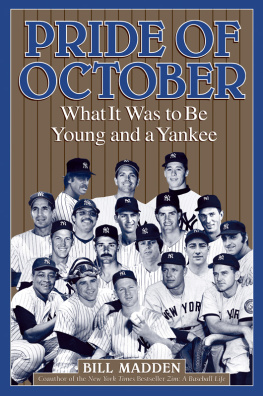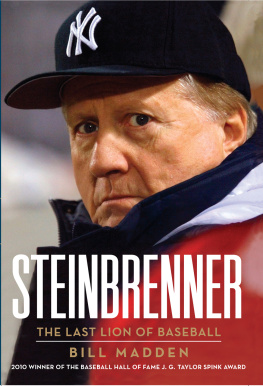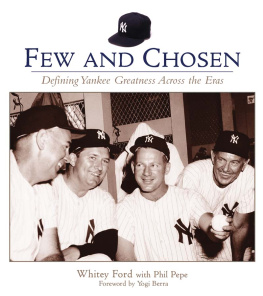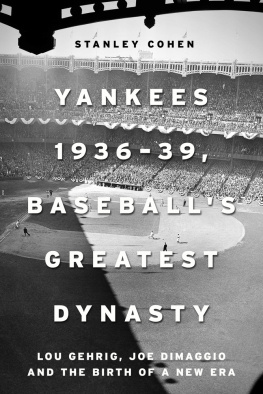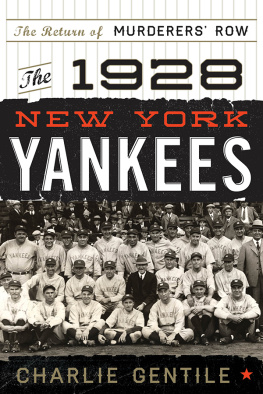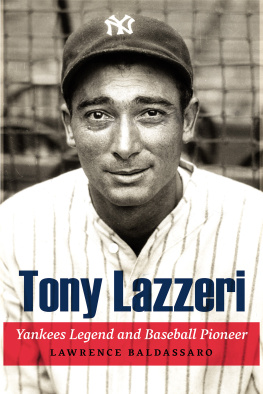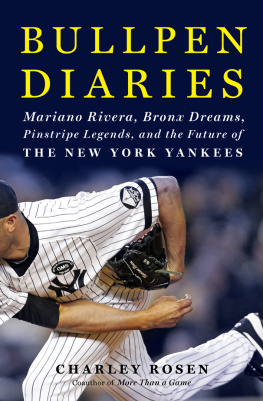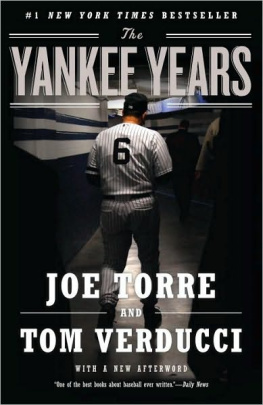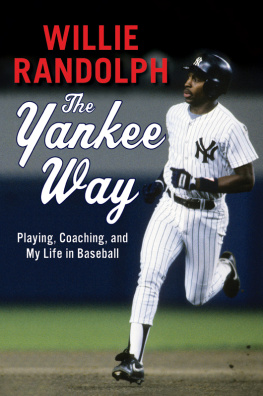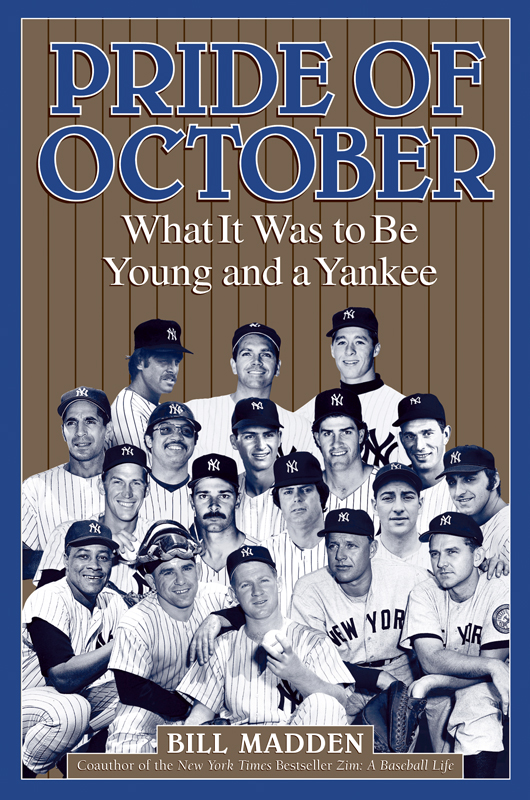Copyright 2003 by Bill Madden
All rights reserved.
Warner Books, Inc., Hachette Book Group, 237 Park Avenue, New York, NY 10017
Visit our Web site at www.HachetteBookGroup.com.
First eBook Edition: December 2008
ISBN: 978-0-446-55460-2
The Warner Books name and logo are trademarks of Hachette Book Group, Inc.
This book is dedicated to the memory of Charles J. Madden, who weaned me on sports writing and newspapers; and took me to my first major league baseball gameYankees-Indians, June 27, 1953, Lopat vs. Garciaand my first World Series game, October 8, 1956.
It is also dedicated to the memory of George McLaughlin, an uncle who was like a second father and who taught me an appreciation for the lore and history of baseball.
The author gratefully acknowledges the following people whose considerable contributions (or, in some cases, just plain friendship and support) helped make this book possible:
Moss Klein, valued friend, and collaborator on a previous Yankees/baseball project for Warner, who served as first proofreader and fact-checker.
The Baseball Hall of Fame, particularly Vice President of Communications Jeff Idelson, for fulfilling a myriad of requests, and Bill Francis, in the Hall of Fame library, who researched countless items of information and provided a mountain of newspaper clippings that served as a supplement to all the information contained in this book.
The New York Yankees. In particular, Rick Cerrone, Director of Media Relations and Publicity, for his cooperation and support through the entire process of this project; Mark Mandrake, Director of Publications and Multimedia, and Managing Editor Glenn Slavin, for their assistance in procuring so many of the vital pictures in this book. Also: Vice President of Marketing Deborah Tymon, who assisted in the location of many of the former players interviewed for this book; Senior Advisor Arthur Richman, and media relations assistants Jason Zillo, Joa Martin and Joe Rocchio, for their assistance in procuring newspaper material, other photographs and statistical and team history information from the Yankee archives.
Marty Appel, a pal for a lifetime and Yankee historian, who was always available at all hours of the day and night to provide vital information, insight and counsel.
Art Berke, Vice President of Communications at Sports Illustrated, a dear friend and longtime colleague who provided the full resources of his magazine in the compilation of research material.
Frank Dolson, longtime friend and writing colleague, who assisted in the editing and fact-checking.
The Elias Sports Bureau: In particular Seymour Siwoff, Steve Hirdt, Tom Hirdt, John Labombarda, Chris Thorne, Bob Waterman, Bob Rosen, Sal DAgostino, Santo Labombarda, Ken Hirdt, Matt Martingale and Todd Betcag, all of whom assisted and provided statistical data essential to this project.
Russ Benedict, Yankee loyalist and early mentor, who provided insight and historical perspective.
Dave Kaplan, director of the Yogi Berra Museum, for his assistance in providing research materials and the museum's other resources for the chapter on Mr. Berra.
Robert Creamer, whose book Stengel was a source for materials on Casey Stengel.
Christopher Longinetti, an adopted son who assisted in the research of the San Francisco sandlot ballparks.
Barry Halper, collector extraordinaire, who furnished letters and other historical data used in this book.
Scotty Browne, Jimmy Converso, Alan Delaqueriere, Pete Edelman, Ellen Locker, Shirley Wong and Faigi Rosenthal from the New York Daily News library, who helped in the research of many of the newspaper accounts used for verification of stories and anecdotes in this book.
Hal Bock and Ronald Blum of the Associated Press, who researched the Jackie Robinson debut coverage.
Fred Chase, one helluva copyeditor and fact-checker.
The late Tom Meany, who once befriended and encouraged an aspiring (very) young sportswriter, and whose 50s historical Yankee profile books, The Magnificent Yankees and The Yankee Story, served as an early inspiration for this book.
Jack Lang for historical perspective contributions.
The late Dick Young and Milton Richman, Hall of Fame baseball writers and mentors.
Phil Pepe, who thankfully adhered to Dick Young's No. 1 Baseball Writers Commandment: Always take care of your beat man.
Bob Raissman and Mark Kriegel, comrades-in-arms who supported.
Elaine Kaufman, believer and counselor of writers who touted and promoted from her bully pulpit.
Dom Amore, student of the game, who provided anecdotes over dinner. Dan Ambrosio, a lifelong Phillies fan who somehow managed to put all that misery aside to contribute mightily to the editing and production process of this book.
Rick Wolff, great editor and baseball man who got this book right away and with his faith, enthusiasm and acumen, made it happen.
Rob Wilson, friend for life, agent, editor and believer who saw to it this book made it into the right hands.
Steven and Thomas Madden, the author's support system.
And lastly, Lil, the pride of all my months and seasons.
Today, I consider myself the luckiest man on the face of the earth.
Lou Gehrig, 1939
I'd like to thank the Good Lord for making me a Yankee.
Joe DiMaggio, 1949
It's great to be young and a Yankee.
Waite Hoyt, 1927
On a chilly, sun-splashed mid-December afternoon in 2001, almost exactly 100 years from the day American League President Ban Johnson finalized plans to transfer his Baltimore Orioles franchise to New York City, Jason Giambi strode to the microphone at the center of the podium in the Great Moments Room of Yankee Stadium and held aloft the size 50, No. 25 New York Yankees jersey he had just contracted to wear for the next seven seasons. Looking down the dais at his father, John, Giambi was suddenly overcome with emotion and, in a barely audible, choking voice said: Look, Pop pinstripes.
Although he had grown up in Southern California, John Giambi had been a lifelong Yankee fan and, in particular, a devotee of Mickey Mantle. During the 50s, the only major league baseball we got was the Saturday afternoon Game of the Week on TV, the elder Giambi explained, and the Yankees, to us, truly were America's team, playing in the World Series just about every year and playing regularly on that Saturday game. I can remember running to the newspaper stand every day and reading about Mickey and the Yankees. If you liked baseball, that's how you grew up then, watching and reading about the Yankees.
After the press conference concluded, the Giambi familyJohn, Jason, his mother, Jeanne, and his fiance Kristian Ricewere escorted down the corridor to the Yankee clubhouse. This is where Mickey walked, said Jeanne Giambi, and now it was her husband whose eyes began welling up. I later said to him: From everything youve said, it would seem this is even more of a dream come true day for you than it is for Jason.
Youll never know how many times I thought about what it must be like to play for the Yankees, John Giambi replied.
I did not tell him I had already begun a journey around the country, seeking out former Yankees from all different eras and, in particular, asking that very question of them. This was the premise of the book I had wanted to write about the Yankees on the occasion of their 100th anniversary. It was given birth by a conversation I'd had at the 1997 World Series between the Florida Marlins and Cleveland Indians, with Charlie Silvera, a seldom-used backup catcher for the Yankees from 1949 to 1956. We were sitting at a poolside table at the World Series gala in Miami and Silvera, who was a scout for the Marlins at the time, was lamenting how much change had come over baseball in the last 40 years with the advent of expansion and free agency.

